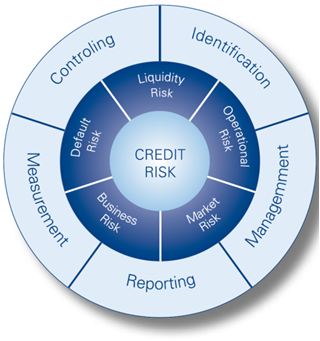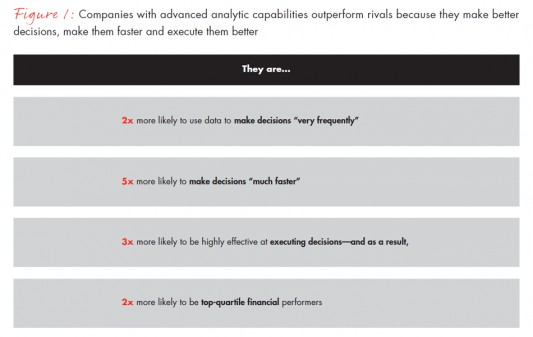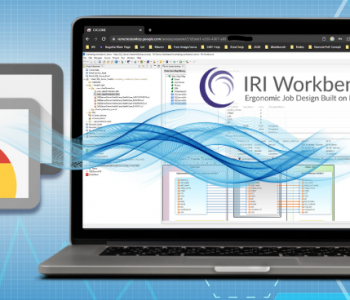
Big Data Analytics in Use
In ancient times, the ability to process and analyze information was invaluable. Greek knowledge of astronomy gave rise to the Antikythera Mechanism, an analog computer with sophisticated bronze gears that predicted astronomical events like lunar phases and eclipses. In the Information Age, we know that capturing and analyzing digital data can produce business intelligence, help avoid risk, gain strategic advantage, and increase profits.
The Antikythera Mechanism (after being submerged for two millennia)
Source: Marcus Cyron – National Archaeological Museum, Athens, Greece
Business Benefits[1]
In the Harvard Business Review study Making Advanced Analytics Work for You, Andrew McAfee and Erik Brynjolfsson found that companies that analyzed data had productivity rates and profitability 5% to 6% higher than their peers. The study highlighted a shipping company’s increase in the “on-time performance of its fleet from specialized weather forecast data and live information about port availability that it hadn’t realized were available.”
In the energy industry, analytics can reduce utility companies’ costs and improve plant efficiency. General Electric’s Monitoring and Diagnostic Center reported that “data-driven insights drawn from [the Monitoring and Diagnostic (M&D) Center’s] volume of power generation . . . have translated to customer savings estimated at $70 million in 2014, up from $53.9 million in 2013.” For business optimization, “predictivity solutions for GE’s power generation customers harness massive volumes of data analyzed . . . to develop solutions that allow them to make more informed operational and business decisions.”
Source: Bain & Company
In the legal field, advanced analytics expedites discovery and reveals data otherwise unknown. Culling through millions of records (many in unstructured formats), advanced analytic technologies can now do (quickly) what was previously impossible (or took too long) to do.
In medicine, a device manufacturer can cull biometric data from implants that can be analyzed for multiple purposes. For example, according to Julian Ackert, managing director of iDiscovery Solutions, “this telemetry can include such information as device ID, date and time information, utilization metrics, and even user profile information. The aggregated data could be potentially relevant to a claim that the devices do not perform as advertised or to the device standards.”
The Fine Art of Financial Analytics
Analytics will permeate the financial industry as nearly every facet of business can be subject to and enhanced through analyzing big data.[2] Michael Versace, Global Research Director for IDC Financial Insights, reported that analytics is among the highest priorities for financial institutions, as it allows them to harness information to make actionable, optimized, and timely decisions; keep risks at anticipated and acceptable levels; and uncover opportunities to stay ahead of the competition. Having complete and analyzed information also alerts executives to emerging trends, enabling them to direct a company away from scandals and margin compression.[3]
Source: KPMG
Versace said that analytic innovation is spreading in the financial services sector, occurring in:
- omni-channel, as customers expect services everywhere they engage with the company
- single view of the customer 2.0, leveraging an integrated back-end DB for a holistic view of all customer relationships (e.g., asset management, mortgages, credit card, banking) and now, outside the company, too (where they drive, their friends, what they buy, etc.)
- analytics everywhere, using data and stats intelligently to create value for customers and the company, which requires big data
- hyper-personalization, improving products and deals based on customer data history
- mobile everywhere, responding to customers who now do everything on their phone
- risk prediction, adding predictability to key indicators based on behavioral data analysis.
As IT revolutionized the financial sector through the 1980s and 90s, advanced analytics will reshape the financial playing field. Robert Kugel of SVP Research observed that “now a new generation of finance department leaders is emerging. These are people young enough to have grown up with technology and are more demanding of software and systems to produce results. The time is ripe for change, and it’s up them to drive finance departments to be more strategic in their use of analytics.”
Analytics as Risk Mitigation
Risk is a fundamental precept, and an inevitable part, of business. One way to minimize risk is through the use of analytics to provide knowledge of how to act and react across business lines. Recognizing patterns and trends, for example, allows an enterprise to optimize advertising and promotional expenditures, thus minimizing marketing fund waste. Monitoring insurance claim data in real-time can immediately flag erroneous information and detect fraudulent activity.
Knowing customer preferences minimizes the risk of releasing a product not well-received by customers. Rather, such knowledge stacks the deck in favor of products designed for customer needs. Conversely, analytics that predict adverse events (like natural disasters) allow business and government agencies to mitigate or prevent the risks associated with those events.
So where yesterday’s business intelligence (BI) initiatives provided more descriptive and diagnostic information, today’s big data analytics can provide predictive and prescriptive information that suggests likely outcomes and courses of action, respectively, based on trends and current data. The capacity to preempt a risk, rather than merely react to it, is invaluable.
“Risk comes from not knowing what you’re doing.”
Warren Buffett
[1] The benefits of advanced analytics is not limited to businesses. In high schools, for example, student-related information on grades, suspensions, and course-load difficulty, may help estimate dropout rates and predict post-secondary success. Educators can use such data to develop personalized reports that improve teaching methods, provide parents with longitudinal evidence, and predict academic performance. Law enforcement can use analytics to predict and reduce crime in particular neighborhoods, and prevent acts of terrorism.
[2] Additional reading on analytics in the BFSI:
[3] From Michael Versace, Global Research Director at IDC Financial Insights on 17 June 2015 in the webinar “Analytics: The Core of Your Digital Strategy” … Opportunities for analytics (at the confluence of digital strategy and competition) in BFSI include disruptors like digital (non-branch) customers, avoiding scandals, and margin compression. About half the firms IDC polled in their 2015 FSI/IT Industry Research Organization survey were at least in a big data analytic pilot stage. Analytics ranked highest among their priorities vs. social media, mobility, cloud computing, and traditional IT.













